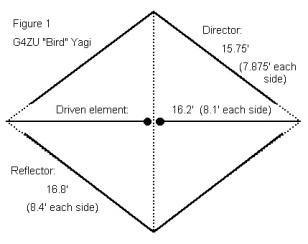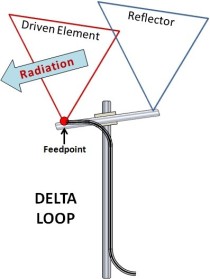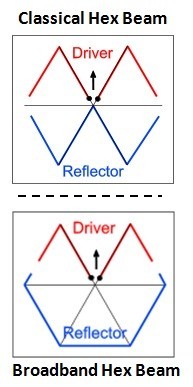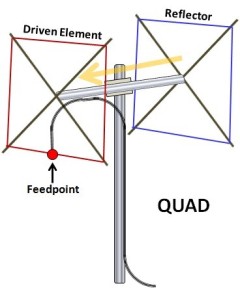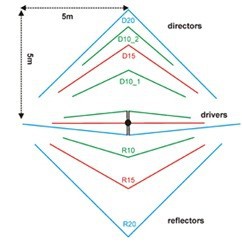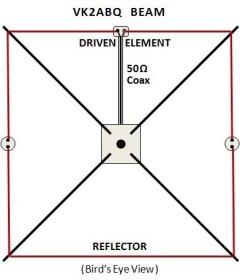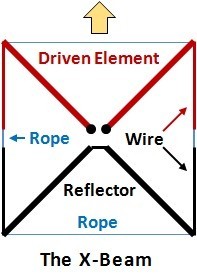WIRE BEAM TYPES
TYPES OF WIRE BEAMS
A Brief Overview:
- Bird Cage
- Bird Yagi
- Bow and Arrow Yagi
- Delta Loop
- HEX Beam
- Moxon Beam (rectangle)
- Octogonal Beam
- Quad
- Spiderbeam
- VK2ABQ Beam (square)
- X-Beam
Remember:
- This site is not a Technology Web Site.
- It is a Practical Solutions Web Site.
THIS PAGE WILL GIVE YOU A QUICK OVERVIEW OF SEVERAL TYPES OF WIRE BEAMS.
I will briefly describe all of these types of wire beams, but I will not go into technical detail on most of these. There are plenty of other sites on the web that do that. Where I can, I will point out links to more information on these antennas.
I will go a little more into detail on the antennas which are currently available on the market as kits, or assembled antennas. These include the Spiderbeam and the Hex Beam.
I will not cover the Quad or Delta Loop in detail, becuse these are 3-dimensional antennas, and are much more complex to build than the Spiderbeam or Hex Beam. Where I can, I will show links to more information on these antennas.
1. The Bird Cage Antenna
The Bird Cage Antenna was designed by Dick Bird, G4ZU (SK).
It is basically a folded X-Beam, and very compact. This was the very first wire beam that I ever built. I got mine to work, at least a little bit, but I could not keep it working. The material I used was too flemsy and it kept collapsing.
Like the Quad and Delta Loop, this antenna is a 3-dimensional antenna, which is partly what makes building it so difficult. There are easier antennas to build than the Bird Cage, but it is probably the smallest Wire Beam of all.
This antenna kind of resembles a bird cage, and since Dick's surname was "Bird", this antenna was called the Bird Cage Antenna. In my 50 years on the air, I have only spoken with a few OM who actually were using this antenna.
L.B. Cebik, W4RNL (SK) wrote an excellent analysis of this antenna.
Here is a Link to more information: The Birdcage Antenna.
IMHO: The Bird Cage Antenna is too much fuss, unless you absolutely must have the smallest antenna possible. Most of the 2-dimensional antennas (e.g. Spiderbeam, Hex Beam, etc.) are much easier to build and give you multiple bands.
2. The Bird Yagi
The Bird Yagi was also designed by Dick Bird, G4ZU (SK).
We all know the joke about "back to the drawing board". Dick Bird took this serious. After the Bird Cage, he designed the Bird Yagi. The Bird Yagi is a Full-Size Yagi, whose parasitic elements ends are bent back towards the driven element.
Performance of this antenna is very close to that of a classical monoband Yagi. By using 4 fiberglass "arms" (spreaders) and wire elements, Dick was able to design a wire beam that was both robust and functional. This antenna was published in The ARRL Antenna Compendium, Volume 2 in 1989 (pages 58-60).
IMHO: The Bird Yagi concept and design is very good. There is limited information about the original Bird Yagi available, but unfortunately Dick Bird is now a Silent Key.
The Spiderbeam is basically the same antenna. You can purchase a complete antenna kit with all of the components required (except Coax), from Spiderbeam, or even a fully assembled antenna. If you prefer to "Do it Yourself", you can even download the Spiderbeam Construction Guide for free, here: SPIDERBEAM CONSTRUCTION GUIDE
3. The Bow and Arrow Yagi
The Bow and Arrow Yagi is just another name for the G4ZU Bird Yagi (described above).
See: 2. The Bird Yagi directly above.
4. The Delta Loop
Like the Quad, the Delta Loop Antenna is a 3-dimensional antenna. Unlike typical Yagi antennas with half-wavelength elements, the elements of the Quad and the Delta Loop are a full-wavelength long.
Formerly there were companies selling Delta Loop antennas commercially, but I haven't seen any recently. Being 3-dimensionals, with full-wavelength elements, these were huge and cumbersom, and tended to come down in storms more often than Yagi (beam) antennas.
Whereas the Quad requires 4 spreaders (supports), the Delta Loop only needs 2, but they are quite a bit longer. As a result, the Delta Loop is not as robust as a Quad. Perhaps this is the reason that the Delta Loop has disapeared from the commercial market.
If you are lucky enough to have several tall trees, building a 2-element Delta Loop beam is easy and very inexpensive to implement. Of course you can't rotate it if it is just wires strung between trees, but you will have outstanding performance for "pennies". (hi)
For an in-depth technical look at the Delta Loop Beam, see: http://www.w8ji.com/delta_loop.htm
IMHO, the Delta Loop Beam is too cumbersome and instable unless you use exceptionally hefty components - and then it's too heavy.
A similar interesting antenna is the Mono-Loop Delta Loop. Or Mono Delta Loop.
These antennas are often just strung between trees and can be very effective. See below.
Stephan Culp, W5SDC has written an interesting article on the Delta Loop. It is only a mono-loop (no reflector), but even this configuration delivers impressive results.
Here is a LINK to more information: Delta Loops for HF .
For info on a low band Mono-Delta-Loop, see here: 40m DELTA LOOP
5. The Hex Beam
"THE" Hex Beam does not exist.
REASON: there are many different types and sources of Hex Beams. It would be difficult to pick just one and call it "THE" Hex Beam. As such, whenever speaking about Hex Beam antennas, it is always a good thing to be specific. Which one or who's Hex Beam are you referring to?
In general we can divide Hex Beam antennas into two catgegories, "Classical" and the G3TXQ "Broadband" Hex Beam.
The Classical Hex Beam is shown on the top of the picture on the right, and the G3TXQ Broadband is shown on the bottom.
- As you can see, the driver in both antennas is shapped like the letter M, requiring just half the space that a straight driven element requires, but also having about half a dB less gain.
- The Reflector in the Classical Hex is also shapped like the letter M. This reduces the required space, but also raises the Q of the antenna, making it narrow banded.
- The Reflector in the Broadband is shapped like the letter "C" on its back.
Although the Classical is smaller, the Broadband Hex has much better gain across the band due to the shape and position of its reflector.
The Classical version is also sometimes referred to as the "Reflected M Beam".
There are several manufacturers of both versions of Hex Beam antennas. These antennas are available either in kit form, or as fully assembled antennas.
The details of both versions of this beam are explained very well on Steve Hunt's (G3TXG), here: Understanding Hex Beam.
Hex Beams, together with the Spiderbeam seem to be the most popular shapes of wire beams, and both are available commercially. Many people also home-brew their own.
IMHO, though its performance does not match that of the Spiderbeam, for people with very limited space, it is probably the preferred solution.
6. The Moxon Beam
The Moxon Beam is the name most often used for a two element beam whose elements are folded towards each other and terminated at a precise distance from each other. It's "kissing cousin" is the VK2ABQ Beam. The main difference is, the VK2ABQ Beam is square and the Moxon Beam is rectangular.
The tip-to-tip element spacing is highly critical with the Moxon Beam.
The problem with trying to build a Moxon beam out of lightweight material is, when the wind blows, the elements move around a bit and the SWR swings all over the place.
A description can be found in Les Moxon's (G6XN) book, "hf antennas for all locations" in Chapter 12, "Horizontal beams".
Although there are some commercial Moxon beams available made of heavy aluminum, I don't know of any commercial wire-version of this antenna.
If you live near water, or are planning an expedition near water, you might consider using a Vertical Dipole Array (VDA). Many of the VDA designs are based on the Moxon principle. See: Vertical Dipole Array .
7. The Octagonal Beam
The Octogonal Beam is very similar to the Hex Beam, except it has 8 spreaders instead of 6.
I can't find any information on this beam. In fact when I googled it, I was linked back to my own website!
I suppose it is just another form of wire beam, similar to the Hex Beam. In theory it would produce slightly less torque on its mast than a Hex or Spiderbeam, but that is offset by the additional weight of the additional fiberglass spreaders.
I know of no commercial source for these beams.
8. The Quad
The Quad is also a wire beam having 2 or more elements, shaped in the form of a square. Sometimes the square is rotated 45 degrees, giving it the shape of a diamond, and called a Diamond Quad. Electrically it is the same as the square quad.
The Quad as we know it was popularized by Clarance Moore, W9LZX, in 1952, while living in Ecuador and working for HCJB (radio station). The Yagi antennas used by HCJB were self destructing regularly, due to the corona discharge off the ends of their elements. By building a beam with closed loops, the problem with corona discharge was eliminated.
Each square is a full wavelength long, which differentiates this antenna from most other wire beams, except the Delta Loop. Like the Delta Loop, the Quad's Elements are also in the vertical plane, rather than in a horizontal plane.
The Quad typically uses fiberglass spreaders with wire elements. The concentric wires of the different bands each form a square around 4 spreaders. In the past, bamboo was often used as spreaders, but in the meantime the commercial ones all use fiberglass.
The Cubical Quad has 8 fiberglass spreaders, grouped in two sets of 4 spreaders. The two sets of spreaders are mounted on oposite sides of the boom. This quad is sometimes referred to as a "Boom Quad". Each set has its 4 spreaders in the same vertical plane. The wire elements on each set of spreaders are concentric with eachother. The spacing between the two sets of spreaders determins the element spacing of the beam and all bands have the same element spacing.
The Spider Quad has no boom. Instead it has a center hub supporting all 8 spreaders. It has advantages and disadvantages. Its main advantage is, the elements on each side of the antenna do not have to be concentric. Thus, by selecting the right angle for the spreaders, you are able to optimise the element spacing for each band. It's main disadvantage is, the fiberglass elements are longer, making it more prone to break in storms.
Like the Delta Loop and Bird Cage Antenna, the Quad is a 3-Dimensional antenna. Thus it is much more cumbersome to work on than other wire beams, and many people are intimidated by its looks. Never-the-less they are outstanding performers and many people swear by them.
In thinking back over my 50+ years on the air, all of the people whom I personally have known using Quads (including myself), eventually switched to Yagi antennas becasue they are easier to build, install and maintain, and they don't break as often as quads do.
I do not intend to go in depth into the Quad Antenna. There are plenty of other good sources of information on this, starting with Wikipedia. You can also consult THE ARRL Handbook or the ARRL ANTENNA BOOK. Another excellent publication is by Bill Orr, W6SAI (SK) entitled All About Cubical Quad Antennas. Radio Publications, 1959.
For a technical description, see: http://www.w8ji.com/quad_cubical_quad.htm
9. The Spiderbeam
The Spiderbeam is a FULL SIZE lightweight multi-band Yagi. It is a commercial version of the Bird Yagi. The original Spiderbeam Yagi was a tribander covering the 20/15/10m bands. As you see in the drawing on the right, it had 3 elements on 20 and 15m and 4 elelments on 10m.
The Triband Spiderbeam was soon followed by a 5 band version, covering the 20/17/15/12/10m bands and then a WARC version covering 30/17/12m, as well as a Low Band version covering 20/17/15m. There are also several other versions available on special order. More on this in the Spiderbeam section of this web site.
The original Spiderbeam was designed to be a high-performance, lightweight Yagi which breaks down to a length of just 4 feet (1,20m) for easily transporting, even by air travel. Having only wires and no traps, these beams are very broad banded, exhibiting excellent performance even on the ends of the bands. For those reasons, the Spiderbeam has become the defacto antenna of choice for most DX-peditions.
These beams are all FULL SIZE. They are not a compact compromise beam. Although the ends of its parasitic elements bend back towards the driven element, it still require almost as much space as a full size 3-element Yagi.
All models of the Spiderbeam are available in two versions:
- "Portable" (extremely lightweight, for expeditions and field work)
- "HD" (Heavy Duty, for permanent installations)
Besides DX-preditions, Spiderbeam Yagi antennas are very popular Field Days, and portable contesting expeditions.
More information can be found in the section of this web entitled "Spiderbeam".
For detailed information on the development of the Spiderbeam see: SPIDERBEAM BASICS.
IMHO, the Spiderbeam is the wire beam with the most performance, yet still lightweight enough to be managable by a single person. Just keep in mind that it requires more space than most of the other wire beams.
10. The VK2ABQ Beam
The VK2ABQ Beam is very similar to the Moxon beam, but it is square instead of rectangular.
It has 2 elements per band, a driven element and a reflector.
The original beam used coat buttons as insulators.
I do not know of any commercial source for this antenna.
A description can be found in Les Moxon's (G6XN) book, "hf antennas for all locations" in Chapter 12, "Horizontal beams".
For an example and more info, see: http://www.scribd.com/doc/19452380/VK2ABQ-Beam-20m15m10m
11. The X-Beam
When looking at it from the top, the X-Beam looks like the letter "X". That's because the support arms are much thicker than the 2 wire elements which bend back towards the center. In my drawing to the right, it looks more like two "M"s opposing each other.
In reality, this is very similar to the classical Hex Beam, but is a little broader, with just the angles forming the outer sides of the "M" being different. This is due to using just 4 spreaders instead of 6.
For monoband antennas, the 4 spreaders may be made of aluminum. For multi-band antennas, they must be of a non conducting material such as bamboo or preferably fiberglass.
The X-Beam was described in detail in The ARRL Antenna Compendium vol. 1. It is not as broadbanded as the "Broadband Hex" or the Spiderbeam. Although its forward gain and front to back (f/b) ratio are good, its front to side ratio is not as good as some of the others.
I am not aware of any commercial source for X-Beams.
IMHO, a Spiderbeam offers a better alternative when using just 4 spreaders.
TO BE CONTINUED . . . (but check out: Spiderbeam vs. Hex Beam )


